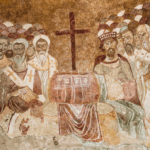This is the introductory post to a short series on the nature of gender. Click here to see the other posts in the series
One of the major reasons why our society finds itself in such turmoil over sex and gender is because we don’t know the story of gender. We (mostly) know that there is such a thing as biological difference between men and women, but we don’t know what those differences mean. Without a framework for understanding maleness and femaleness we’ve turned “masculinity” and “femininity” into expressions of culture or personal feeling.
Evangelical theology has not helped this situation very much. Although (so I’m going to argue) we have the resources to tell the story of gender, we’ve neglected to do so. We’ve had lots of arguments about how we should act as men and women. We’ve done a good job of insisting that there are differences between men and women. But we haven’t really explained what those differences are or mean theologically. Accordingly, our discussions have tended to float on the surface. We’ve been talking about the meaning of words without getting to the meaning of gender itself.
The same problems have sometimes beset our response to same-sex relationships. Although we’ve rightly explained that God’s commands aren’t arbitrary—that they come from a creation story in which men and women are different and complementary—we’ve too often neglected to ask deeper questions about this story. We haven’t done enough to show why these differences matter. After all, if we don’t know how a man and woman are supposed to be different, how can we be sure that two men or two women can’t exemplify the same complementarity?
Of course, the problem isn’t that we’re wrong to look closely at the Bible; nor is there anything wrong with pointing to creation as the basis of our complementarity. But I think we’ll do even better if we can work out what gender is. This five-part series is a (very brief) attempt to introduce a theology of gender. I want to begin, not by trying to find the essence of masculine or feminine behaviour, but by thinking about how sex-differences arise out of—and relate to—the story of the Bible.
Three Preliminary Notes:
Here are a few things to keep in mind as you read this series.
1. Theological Truth is Complex
Theological truth is complex. We worship a God who is a one and three; who is sovereign, yet who gives humans real choices; who is above space and time and comprehension, yet who dwells with the lowly and listens and responds to prayers.
Accordingly, we often find that theological thinking requires us to hold different ideas in tension—even when we can’t fully understand how they fit together. It’s not either-or, but both-and. As Charles Simeon put it: “truth is not in the middle, and not in one extreme, but in both extremes.”
The reason I bring this up here is because I am going to suggest that the Bible’s teaching on gender and sexuality contains several tensions, and we need to be careful not to try and resolve those tensions by getting rid of one. If we find that some parts of the Bible are patriarchal and others seem more egalitarian, we aren’t allowed to simply ignore one side of the equation. Rather, we have to think about how the two are related and how they are balanced.
2. Theological Truth Should Tell a Story
In the posts ahead I will be offering, rather than defending, interpretations of some key contested passages. Others have read these differently on the basis of word-studies and educated guesses about historical context. Readers might wonder why my readings should be preferred.
My brief answer here is that theological truth isn’t just about fine detail (though that’s important too) but about the big picture. The Bible is ultimately a single book written by God about his Son, and sometimes we need a wide-angle reading of Scripture that can help us see the shape of the forest.
In the posts ahead this is how I will try to commend my reading. Sometimes I will make some brief notes to show that my interpretation doesn’t ignore language and cultural debates. But the real test is whether what I’m saying makes sense of the Bible’s story.
Not everyone will be convinced by this. But I would encourage those who aren’t to work hard at offering their own big picture. It’s what we need right now.
3. A Note on Terminology: Gender vs Sex
In modern discussion, it is common to distinguish “sex” from “gender”. The first refers to biological reality. The latter has to do with feelings and social-expectations associated with (or, sometimes, disassociated from) sex. Generally, “sex” pertains to biological fact; “gender” to meaning.
Although I am very skeptical of the way this approach tends to separate sex and gender, I think the terminological distinction itself is helpful: “gender is a more fundamental reality than sex,” as C.S. Lewis puts it.[1] In these posts, I will use “gender” to describe the meaning or significance of sex difference—not in terms of personal feeling or social stereotypes, but from a theological perspective. Gender, in other words, is what God means by sex. It is the story God wants to tell about, and through, sex.
Next Post —>
Image: Jan Brueghel the Elder
[1] C. S. Lewis, Perelandra (NY: Simon and Schuster, 1996), 172















